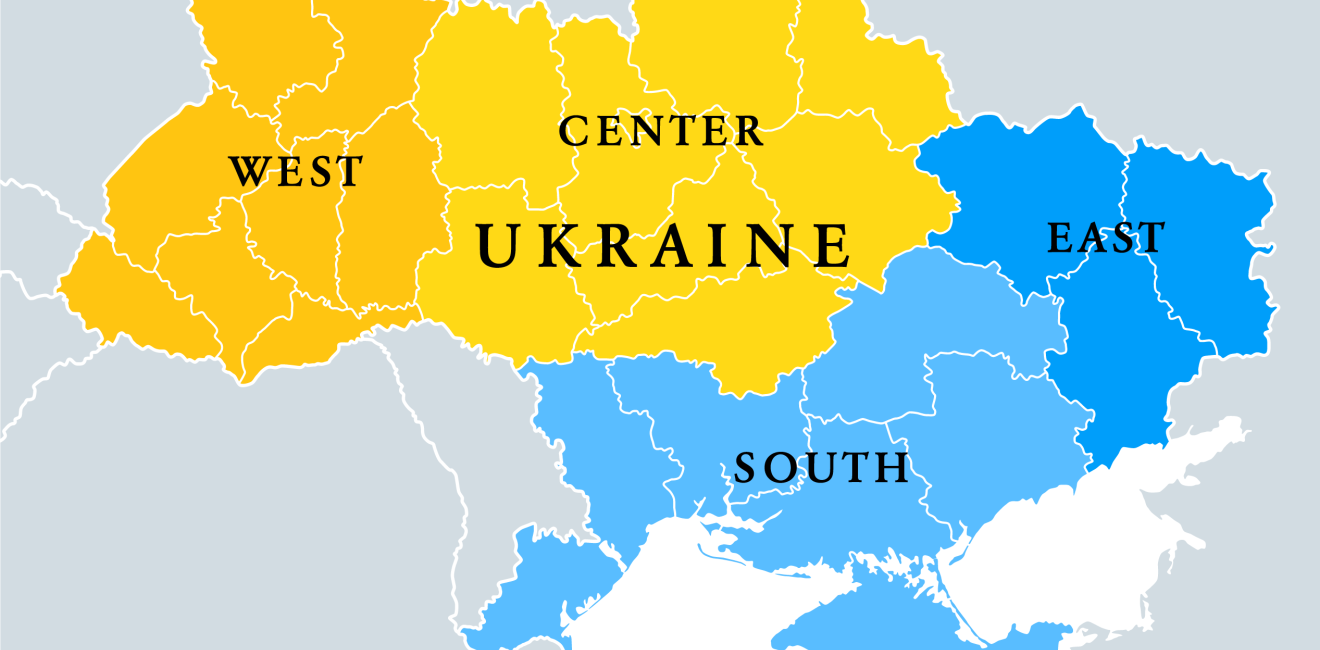
A blog of the Kennan Institute
BY MYKHAILO MINAKOV
After five months of all-out war, the Kremlin appears to have refined its plans for the future of the temporarily occupied territories in southeastern Ukraine.
Currently Russian forces control about 20 percent of this Ukrainian territory, once populated by over eight million people. Today those parts of Donetsk, Luhansk, Kharkiv, Kherson, and Zaporizhzhia oblasts that are under Russian military control are only thinly populated: local people have fled the battles and missile strikes, going either to Ukrainian government–controlled regions, to Europe, or to Russia.
For those who remain, the Kremlin has a new plan: annexation instead of secession. Annexation would ensure Moscow’s control over the local population and extend its “nuclear umbrella” onto the newly conquered land.
Annexing Lands
Three month ago I reported on the Kremlin’s plan to hold local referenda on secession of the Russian-controlled territories of southeastern Ukraine. However, it seems that the Kremlin’s plans have changed: the referenda now aim at creating quasi-legal grounds for annexing this land.
For example, on July 23, Yevgeny Balitsky, the Russian-appointed “head of the temporary administration of Zaporizhzhia oblast” (operating on the territory occupied by Russian troops), signed a decree to create an election commission as the first step to holding a referendum on Zaporizhzhia oblast becoming part of Russia. The referendum may be held in the first half of September 2022.
That same day a decree with the same language was signed by deputy head of the Kherson regional administration Yekaterina Gubareva. Should the battles in Donbas taper off or end, the Russian proxy–controlled governments of the self-proclaimed Donetsk People’s Republic (DPR) and Luhansk People’s Republic (LPR) most likely will sign off on similar decrees.
The Kremlin’s choice of annexation—making these lands just a regular part of the Russian Federation—is evidently connected to Moscow’s declining trust in the local elites and the subjugated communities. Russian-installed governors and mayors of Ukrainian origin—Yevgeny Balitsky in the occupied parts of Zaporizhzhia oblast, Vladimir Saldo in Kherson oblast, Galina Danilchenko in Melitopol, Konstantin Ivashchenko in Mariupol—have neither local support nor the administrative know-how sufficient to satisfy their new masters.
Which is why the Russian authorities have recently appointed so-called “heads of the regional executive bodies” from among Russian bureaucrats. At the beginning of July Anton Koltsov, former first vice-governor of Vologda oblast, became head of the government of Zaporizhzhia oblast, while Sergey Eliseyev, ex-deputy head of the Kaliningrad government, became chairman of the government of Kherson oblast. The role of Russian officials is also growing in the DPR and LPR.
This marks a sea change in Russia’s approach to the conquered territories. For about thirty years, Moscow supported self-proclaimed republics on the territories of Georgia (South Ossetia and Abkhazia) and Moldova (Transnistria), and subsequently in Ukraine (the DPR and LPR). But despite having fully Kremlin-loyal “presidents,” the de facto statelets in Georgia and Moldova and their populations still had some level of agency that forced Russia to constantly bargain with them through kuratory, the Kremlin special appointees for these issues. In a war situation, however, the controlled communities are not allowed any agency. They must obey the new authorities without question.
At this point, moreover, the Russian government seems ready to raise the stakes in the war. After the annexation of Ukraine’s southeastern territories by referendum goes through this fall, Moscow can claim that the shelling of these regions would constitute an attack on Russia, which would allow the Kremlin to respond with nuclear weapons, as prescribed in the Russian Federation’s National Security Strategy.
Annexing Minds
Along with land, the Kremlin plans to annex local communities’ hearts, minds, and wallets. Moscow is speeding up the linkage of conquered communities with communities in Russia, constructing a new tax system compatible with the Russian system, and establishing new educational curricula in the conquered Ukrainian territories to integrate youth into the Russian educational system.
Last May the first deputy head of the Russian presidential administration, Sergei Kiriyenko, declared that the reconstruction of cities and transport infrastructure in the conquered territories would follow the Crimean model. After Russia’s annexation of Crimea in 2014, sixteen Russian regions were assigned to different cities and districts of the peninsula to help them survive sanctions and integrate into the Russian Federation.
Now the Russian Federation regions are to take Ukrainian territories under their “guardianship.” By the end of July 2022, more than thirty Russian regions will have assumed patronage of various cities and districts in southeastern Ukraine. For example, pro-Russia officials and mayoral offices are preparing St. Petersburg and Mariupol for a partnership that will allow local authorities to start reconstructing the destroyed city. These partnerships are controlled by Russian deputy prime minister Marat Khusnullin and the RF Ministry of Construction.
Simultaneously, the pro-Russia local administrations are developing an increasingly extensive tax collection system. According to an edict of the Russian military-civil authorities, all individuals and companies must register as taxpayers in the occupied lands by August 1, 2022. This nullification of Ukrainian taxation authority goes hand in hand with Russian “passportization”: the local population is forced to accept Russian citizenship in order to access basic services in their communities.
The process is moving rather slowly, however. For example, in Berdyansk, a pleasant Azov seaside city with over 100,000 population before the war, only 800 local residents have received Russian citizenship, though as many as 4,500 have applied for it. Moreover, Ukrainian populations on the temporarily occupied territories are discouraged from acquiring Russian citizenship by Kyiv, which is preparing an act to criminalize such behavior.
The occupying administrations are also building a new secondary education system, appointing new loyal school principals and getting teachers from Russia involved. As of September 1, schoolchildren in the occupied territories of Ukraine will study according to “Russian standards.” Officials are hurriedly looking for principals and teachers. So far about 250 teachers from thirty-one Russian regions have applied to teach in southeastern Ukraine. They are promised salaries ranging from 7,000 to 8,600 rubles ($120–$150) per day.
Insecurity of the Pro-Russia Collaborators
With more long-range arms delivered by the West to Ukraine, the shelling of critical targets in Berdyansk, Donetsk, Luhansk, and Kherson has stepped up. For example, Ukrainian forces recently hit Russian-controlled bridges in Kherson oblast to slow the advance of Russian troops and munitions. Russian anti-aircraft and anti-missile systems are not sufficient for the occupiers to defend military and civilian infrastructure on the occupied land.
This situation led Russian foreign minister Sergei Lavrov to declare on July 20 that Moscow's military “tasks” in Ukraine had gone beyond the eastern Donbas region: the Kremlin plans to grab more land to ensure that its aims in Crimea and the Donbas can be secured.
The security of pro-Russia officials and Russian servicemen in the occupied territories is not assured at all. Despite the newly created system of militarized police—comprising Russian soldiers, the DPR and LPR militias, and other local collaborators—the number of attacks on Russian officials and military staff by local pro-Ukrainian resistance groups is growing.
So far the Russian military administrations have not managed to establish order on the occupied territories. To prevent annexation by Russia, the Ukrainian army is preparing a counteroffensive aimed at liberating the conquered lands and communities. This is the only real way to stop the new Kremlin policy from going into effect.
The opinions expressed in this article are those solely of the author and do not reflect the views of the Kennan Institute.
Author


Kennan Institute
After more than 50 years as a vital part of the Wilson Center legacy, the Kennan Institute has become an independent think tank. You can find the current website for the Kennan Institute at kennaninstitute.org. Please look for future announcements about partnership activities between the Wilson Center and the Kennan Institute at Wilson Center Press Room. The Kennan Institute is the premier US center for advanced research on Eurasia and the oldest and largest regional program at the Woodrow Wilson International Center for Scholars. The Kennan Institute is committed to improving American understanding of Russia, Ukraine, Central Asia, the South Caucasus, and the surrounding region through research and exchange. Read more

Explore More in Focus Ukraine
Browse Focus Ukraine
Talking to the Dead to Heal the Living

Ukrainian Issue in Polish Elections


